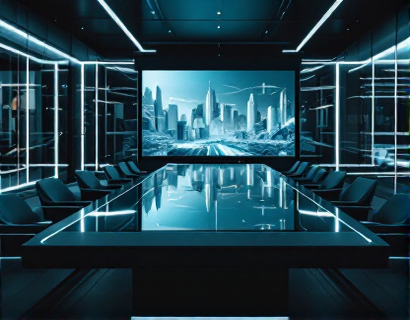UX Design Trends 2025: Mastering Digital Transformation for Enhanced User Experience
In the rapidly evolving landscape of digital products and services, UX design plays a pivotal role in driving success and enhancing user satisfaction. As we step into 2025, the field of UX design continues to evolve, influenced by technological advancements, changing user behaviors, and emerging design trends. This comprehensive guide aims to equip UX designers and enthusiasts with expert strategies, practical tips, and the latest trends to master digital transformation and elevate their UX design practice.
Understanding the Current UX Design Landscape
The UX design landscape in 2025 is characterized by a focus on inclusivity, personalization, and seamless integration of technology into daily life. With the increasing use of AI and machine learning, UX designers are leveraging these technologies to create more intuitive and adaptive user experiences. The pandemic has accelerated the shift towards digital, making user experience more critical than ever. Designers must now consider not only the usability but also the emotional and contextual aspects of user interactions.
Accessibility remains a top priority, with more organizations recognizing the importance of designing for diverse user needs. The Web Content Accessibility Guidelines (WCAG) continue to guide designers in creating inclusive digital products. Additionally, the rise of voice interfaces and augmented reality (AR) is reshaping how users interact with digital content, presenting new opportunities and challenges for UX designers.
Trend 1: Emphasizing Inclusivity and Diversity
Inclusivity in UX design is no longer a niche concern but a fundamental aspect of creating effective digital products. Designers are increasingly adopting a user-centered approach that considers a wide range of user characteristics, including age, ability, culture, and socioeconomic background. This shift is driven by a growing awareness of the diverse needs of the global user base and the legal and ethical imperatives to design for everyone.
To implement this trend, designers should conduct thorough user research that includes underrepresented groups. Techniques such as co-design workshops, surveys, and usability testing with diverse participants can provide valuable insights. Additionally, using inclusive language and imagery in design prototypes and final products helps ensure that all users feel represented and valued.
Trend 2: Personalization and Adaptive Interfaces
Personalization has become a key differentiator in the digital space, allowing users to tailor their experiences to their preferences and behaviors. Adaptive interfaces that adjust in real-time based on user interactions and context are gaining traction. These interfaces use data and AI to provide a more relevant and engaging experience, enhancing user satisfaction and loyalty.
Designers can leverage machine learning algorithms to analyze user data and create dynamic content and layouts. For instance, a news app might prioritize articles based on a user's reading history and current interests. To achieve this, it's essential to balance personalization with privacy, ensuring users feel in control of their data and experience.
Trend 3: Seamless Multi-Device Experiences
The proliferation of devices, from smartphones to smart home devices, has led to a demand for seamless multi-device experiences. Users expect a consistent and cohesive experience across all their devices, regardless of where they start their interaction. This trend, often referred to as omnichannel design, requires a holistic approach to UX design that considers the entire user journey.
To deliver seamless multi-device experiences, designers should focus on responsive design principles and ensure that digital products are fluid and adaptable. Using design systems and component libraries can help maintain consistency across devices. Additionally, considering the unique interactions and contexts of each device, such as voice commands for smart speakers or gesture-based controls for AR devices, is crucial.
Trend 4: AI and Machine Learning Integration
The integration of AI and machine learning into UX design is transforming how designers create and optimize digital products. These technologies enable more intelligent and responsive interfaces, from chatbots that provide real-time assistance to predictive analytics that inform design decisions. AI can also automate repetitive tasks, allowing designers to focus on more creative and strategic aspects of their work.
Designers should explore tools and platforms that incorporate AI, such as design automation software and data-driven design systems. For example, using AI to analyze user feedback and behavior can help identify pain points and areas for improvement. However, it's important to maintain a human touch, ensuring that AI enhances rather than replaces the designer's role.
Trend 5: Voice User Interfaces (VUIs)
Voice user interfaces are becoming increasingly prevalent, driven by the popularity of smart assistants like Siri, Alexa, and Google Assistant. VUIs offer a hands-free, conversational way to interact with digital products, making them particularly useful for tasks that require quick access or are better suited to voice commands. This trend is especially significant for accessibility, as voice interactions can be more accessible for users with certain disabilities.
To design effective VUIs, designers need to focus on natural language processing and conversational flow. This involves creating intuitive prompts, handling ambiguity, and ensuring that the voice interface feels natural and engaging. Conducting voice usability testing and iterating based on user feedback is essential to refine these experiences.
Trend 6: Augmented Reality (AR) and Virtual Reality (VR)
AR and VR technologies are opening new frontiers in UX design, offering immersive and interactive experiences that were previously impossible. These technologies are finding applications in various domains, from e-commerce and education to entertainment and training. AR, in particular, allows users to overlay digital information onto the real world, enhancing the context and relevance of the content.
Designing for AR and VR requires a deep understanding of spatial design and user movement. Designers should consider factors such as field of view, motion sickness, and user comfort. Prototyping and testing in real-world scenarios are crucial to ensure that AR and VR experiences are intuitive and enjoyable. Collaborating with developers and other stakeholders is also essential to bring these innovative ideas to life.
Practical Tips for Implementing Trends in UX Design
While staying abreast of the latest trends is important, it's equally crucial to apply these trends in a way that aligns with your project goals and user needs. Here are some practical tips to help you integrate these trends into your UX design practice:
- Conduct User Research: Always start with a deep understanding of your users. Use a mix of qualitative and quantitative methods to gather insights that inform your design decisions.
- Iterate and Test: Embrace an iterative design process, continuously testing and refining your designs based on user feedback. This approach helps ensure that your designs meet real user needs and expectations.
- Use Design Systems: Implement design systems to maintain consistency and efficiency across devices and platforms. This helps in creating a cohesive user experience and simplifies the design process.
- Leverage AI Tools: Explore AI-powered design tools to streamline tasks such as prototyping, testing, and data analysis. These tools can save time and provide valuable insights to enhance your designs.
- Focus on Accessibility: Prioritize accessibility in every stage of the design process. Use accessibility guidelines and tools to ensure that your designs are usable by everyone.
- Stay Flexible: Be open to adapting your designs as new technologies and user behaviors emerge. Flexibility is key to staying relevant and effective in a rapidly changing digital landscape.
By embracing these trends and practical tips, UX designers can drive digital transformation and create exceptional user experiences that stand out in a competitive market. The key is to remain user-focused, innovative, and adaptable, ensuring that your designs not only meet current needs but also anticipate future possibilities.











































